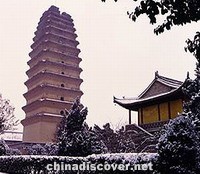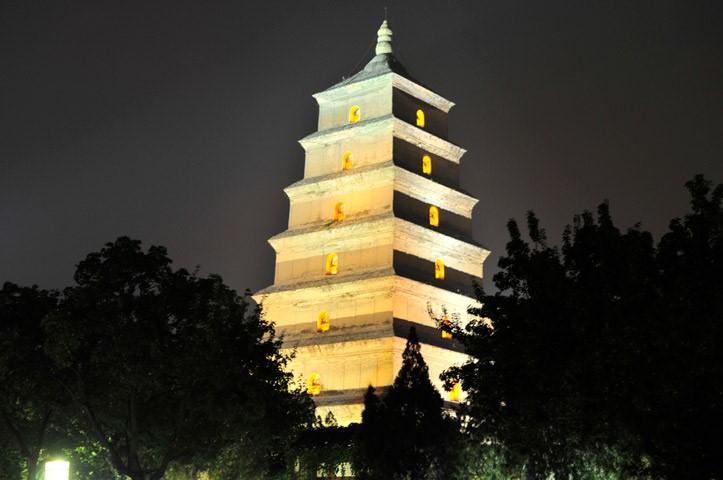Small Wild Goose Pagoda

The Small Wild Goose Pagoda stands in Jian Fu Temple, one kilometer south from the downtown area. If the Big Wild Goose Pagoda can be compared to a stalwart young man, the Small Wild Goose Pagoda is then like a delicate, slim girl.
Inside the temple there is a huge iron bell dating from the Kin Dynasty (1192). The sound of the bell is crisp and pleasant, and can be heard as far as five kilometers away. People here simply call it the "Magic Bell". It is 4.5 meters in height, 7.6 meters in diameter along the rim, and 10 tons in weight. It is carved with characters that denote the following: Long live the Emperor; the vessels help Him for ever; May the Buddhist principles prevail in the time to come. In fact, there is an interesting story about the Bell. It is said that if one missed his beloved relations who are living far away from him, the only thing he needs to do was to write their names and addresses on a piece of yellow paper, and the sound of the Bell would pass the message to them. Hence, the " Morning Bell Chimes of the Pagoda" is one of the eight famous scenic features in the province.
Jian Fu Temple was built in 684, in order to pay homage to the Tang Emperor, Li Zhi, upon the centenary of his death. Therefore, it was originally named Xian Fu Temple. The present name did not come into being until 698 A.D. The Temple was also the place where the great translator Monk Yijing translated Buddhist scriptures. Yijing set out by sea for India in search of Buddhist principle in 671. He came back with some four hundred volumes of holy Sanskirt scriptures after traveling over thirty countries, for more than 20 years. On his way back to China, he stayed on Island of Sumatra in Indonesia and did some investigation there. Yijing translated altogether 56 volumes of scriptures in Jian Fu Temple and wrote the book Biography of Eminent Monks in the Tang Dynasty in Search of Buddhist Truth in India . The book can be regarded as a companion to Pilgrimage to India by Xuanzang, and is of great help to the study of Chinese and Indonesian history, as well as the history of the cultural relationship between China and Indonesia.
The Small Wild Goose Pagoda was set up in 707. It has 15 storeys and is about 45 meters in height. The story goes that when Yijing appealed to the imperial court for funds to build a pagoda, so as to preserve the holy scriptures that he had brought back from India, the cowardly Emperor Li Xian asked for the Queen's advice as he often did. When she heard of this, she ordered all the imperial concubines and court maids to donate money for the construction of the pagoda. The ladies were so generous in their donation, that there was still money left over even after the pagoda was finished.
In the long history of its existence, there has even been a "magic healing" of the Pagoda! In 1487, there was an earthquake of 6 points on the Richter scale and a one-foot crack formed in the Pagoda from the top to the bottom. However, in 1521, 34 years after the quake, there came another one. The crack healed overnight. This amazed the local people. Therefore they began to call it the "Magic Healing". In September 1555, an official from the capital, named Wang He, stayed in the temple for a night on his way home. After he heard the story of the "Magic Healing" from a monk called Kanguang who had personally witnessed the incident, out of disbelief he engraved this story on the lintel of the Pagoda's north gate. However, when repair work started after 1949, it was found that the healing was not "magic", but "human". The early builders of the pagoda had made the foundation into the shape of a hemisphere in accordance with the geographic nature of Xi'an. The foundation therefore evenly divided the stress of the earthquakes. Thus, after enduring 70 quakes, the pagoda still stands as firm as when it was first established. Looking at this, we can only admire the marvelous workmanship of the ancient





